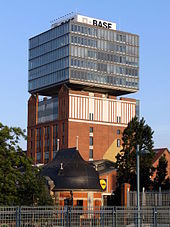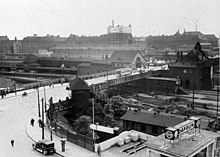Oberbaum City
The area of the former Narva Berliner Glühlampenfabrik (formerly: Osram Werk D [Drahtwerk]) in the Rudolfkiez of the Berlin district of Friedrichshain between Warschauer Strasse station and Ehrenbergstrasse has been known as Oberbaum City since around 1999 .
The urban landmark of the area north of the Spree near the Oberbaumbrücke is the 16- storey Narva tower , which is 63 meters high . The Narva Tower ( House 3 ; Rotherstraße 11) was completed in 1909, initially with ten storeys, based on a design by Theodor Kampffmeyer (1856–1913). With a height of over 40 meters at the time, it was the first skyscraper in Berlin and one of the first skyscrapers in Germany .
history


The development of the area began at the beginning of the 19th century with the first Berlin "waterworks in front of the Stralauer Thor " for drinking water treatment, which went into operation in 1856.
With the opening of the main line (today's underground line U1 of the Berlin underground ), the area was also connected to the new " elevated and underground railway" via the neighboring terminus at Warschauer Brücke in 1902 .
When the waterworks ceased operations around 1893, Deutsche Gasglühlicht AG ( Auer-Gesellschaft ) bought the area and had four building complexes built on the site between 1906 and 1914 as a production facility and administrative headquarters.
The foundation stone for the so-called "Lamp City" was laid. Deutsche Gasglühlicht AG spun off its incandescent lamp business in November 1918 and founded Osram GmbH KG , which in 1920 was joined by the other two large German incandescent lamp manufacturers, Siemens & Halske and AEG with the Helmholtzstrasse in Charlottenburg (Plant S; Siemens) and Sickingenstrasse in Moabit (Werk A; AEG) involved. In 1935, Osram also took over the Bergmann Electricitäts-Werke factory on Seestrasse in Wedding (Plant B; Bergmann, today's Carrée Seestrasse ). At that time, glassblowers were still employed in their own glassworks at the Berlin location . The glass bulbs were later largely produced in Weißwasser / Oberlausitz (Plant W). The gas incandescent “lamp city” in Friedrichshain became Osram-Werk D (wire works) and was also the company's headquarters until 1945.
In 1949 the former Osram “wire factory” became public property . The VEB Berliner Glühlampenwerk " Rosa Luxemburg " was created , which in 1969 was merged with other lamp manufacturers to form the GDR - Kombinat " Narva ". At that time, over 5000 people were employed at the Friedrichshain site.
After the war damage was repaired at the beginning of the 1950s, the high-rise building, which was extended in 1963 with a burn-time test room in the form of a glass cube, became the “Narva Tower”, a shining landmark that can be seen from afar. Narva established itself as the largest light bulb manufacturer in the GDR and exported its lamps to over 50 countries.
After German reunification , incandescent lamp production was stopped in 1992 and the building complex was entered in the monument book.
Between 1993 and 2000, HypoVereinsbank developed five buildings on the site of the former “Lamp City” into modern office and commercial buildings. The Wilhelminian style façades , which are listed as historical monuments , have been restored, the buildings partially completely gutted and completely renovated. Behind the historical walls, new, architecturally appealing office space of the same construction was created in all buildings.
The architectural reinterpretation of the former Narva Tower was developed in close cooperation with the monument protection department . According to the drafts of the architects Schweger + Partner, the tower was raised by five more floors with a glass and steel construction and again gives the Oberbaum City a distinctive and contemporary landmark.
Part of the building complex has been leased since 2005 by the German chemical company BASF , which has set up an international shared service center at the site. Oberbaum City is currently an office and business district for both established and young creative companies from various economic sectors.
Around 3500 employees work at the site for around 80 companies.
On February 18, 2019, it was announced that Oberbaum City was taken over by the private equity companies Blackstone Group and Quincap at a price of 500 million euros from HVB Immobilien , a subsidiary of the Unicredit Group .
literature
- Building with steel , documentation 606 - revised version 2001, steel structures in Berlin . Ed. Bauen mit Stahl e. V., Düsseldorf, 2001; P. 13
- The architectural and art monuments in the GDR , Berlin, Volume I, pp. 466–467; Institute for Monument Preservation at Henschelverlag, 1984
Web links
- Information sheet on the light bulb quarter from the Berlin Center for Industrial Culture
- Oberbaum City . In: District lexicon of the Luisenstädtischer Bildungsverein
- State monument list Berlin: former Auer society or Berlin light bulb factory
- State monument list Berlin: Narva, building 3
- Oberbaum City. In: arch INFORM . - Office tower (Narvaturm)
Individual evidence
- ↑ State monument list Berlin: Narva, building 3
- ↑ Architektur-Bildarchiv , accessed on September 6, 2014
- ↑ Berlin Oberbaum City sold for almost 500 million euros. In: immobilien-zeitung.de . Retrieved February 19, 2019 .
Coordinates: 52 ° 30 ′ 13 ″ N , 13 ° 27 ′ 5 ″ E


